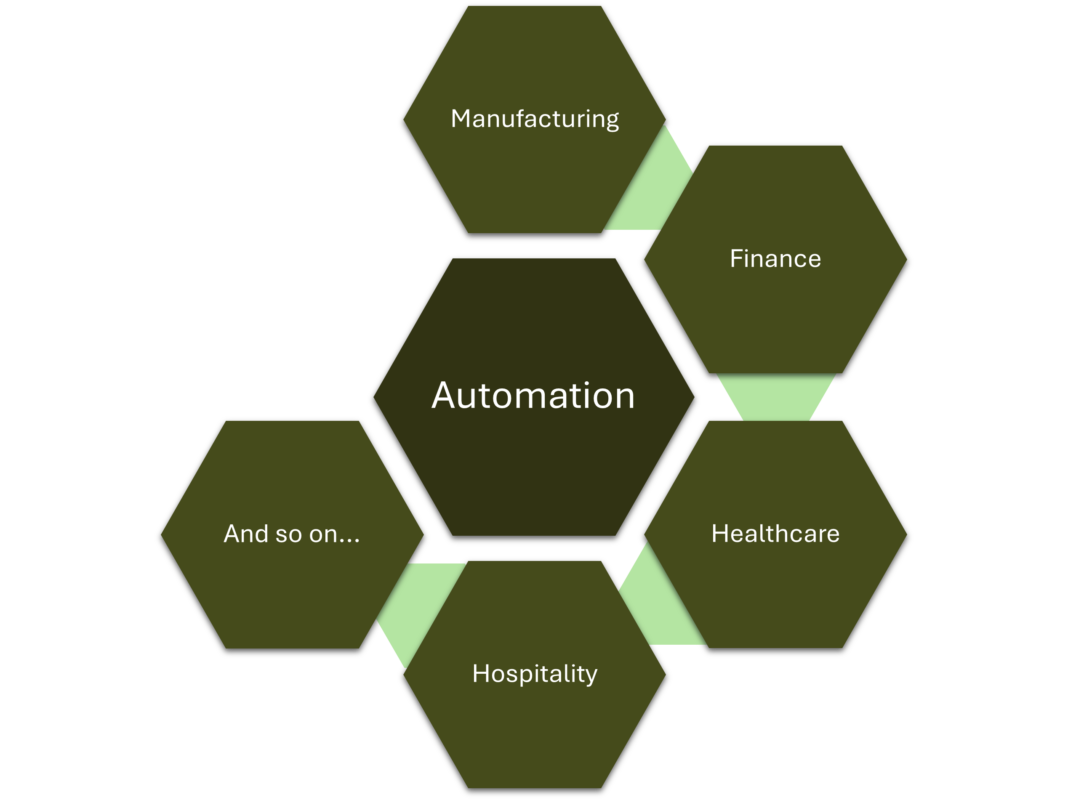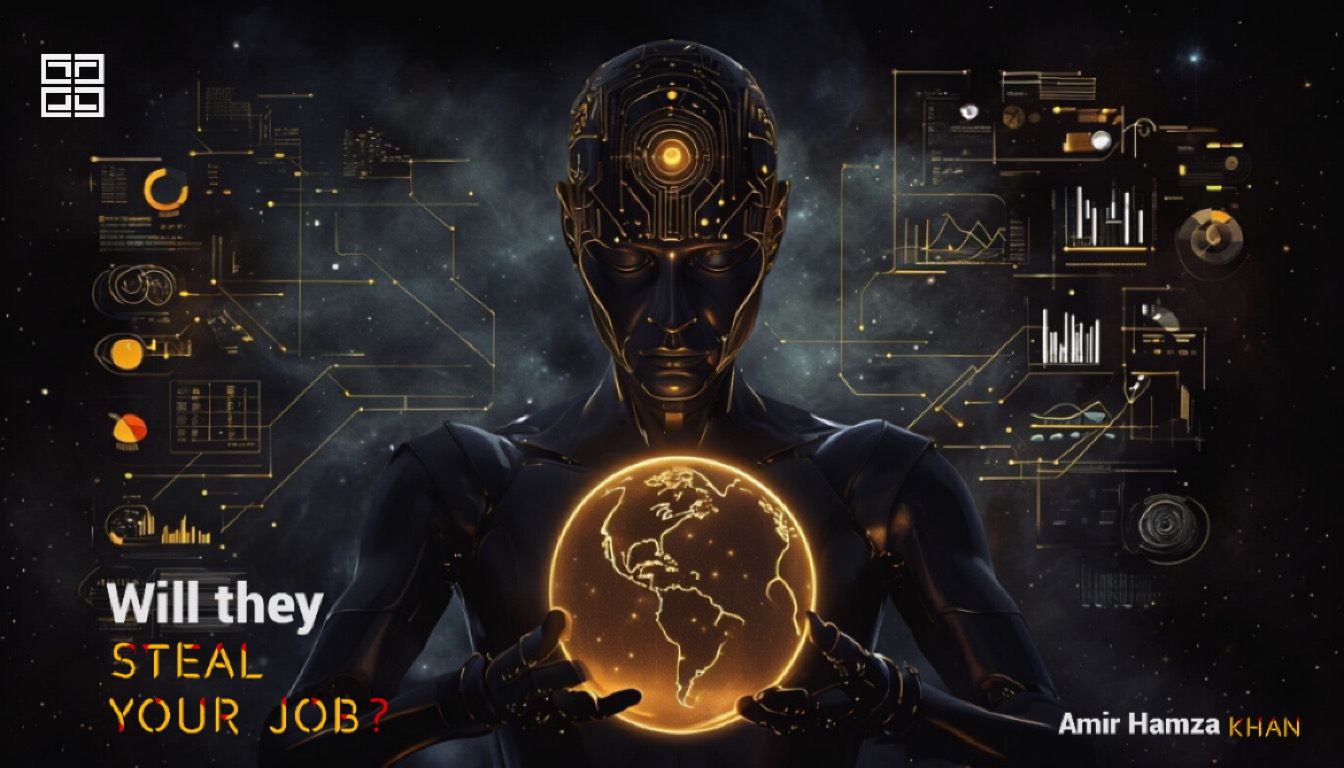Evolving with Machines: How Automation Shapes Human Employment
Automation rapidly transforms industries by streamlining operations, reducing costs, and improving efficiency. In manufacturing, for instance, robotics and AI-driven machines are replacing manual labor for tasks like assembly, quality control, and inventory management, leading to faster production cycles and lower error rates [1]. The logistics industry has adopted automated systems for order processing, package sorting, and even delivery—as seen with autonomous drones and self-driving trucks—which improve both speed and accuracy [2]. In healthcare, automation aids in diagnostics and administrative tasks, freeing up time for medical professionals to focus on patient care [3]. This article analyzes the current idea of “artificial intelligence taking over” from a holistic and historical perspective. It advocates that by drawing parallels to Darwin’s theory of evolution, we can recognize that automation is not a threat to human employment but rather a catalyst for adaptation and growth. The article concludes that if machines take on routine tasks, humans can focus on higher-level cognitive abilities, creativity, and problem-solving.
1.Automation & Industries
While the rapid advancement of automation, robotics, and AI has raised concerns about job displacement, a historical perspective reveals a different story. Below are a few examples where automation has made significant contributions.

1.1. Manufacturing
The integration of automation in manufacturing through technologies like industrial robots, AI, and IoT is revolutionizing production lines. These advancements have increased productivity and minimized defects, enabling mass customization and faster response times [4]. For instance, BMW and Tesla leverage automation to enhance assembly processes and ensure quality consistency, reshaping global supply chains [5].
1.2. Finance
Automation in finance, particularly through robotic process automation (RPA) and AI, has streamlined tasks such as data entry, risk assessment, and fraud detection. Algorithms now handle tasks that in the past required human input, such as approving loan applications and managing customer service through chatbots, enhancing efficiency, and reducing errors [2], [6].
Read widely—Explore literature from various scientific disciplines, philosophy, history, and even fiction to stimulate fresh perspectives.
Attend interdisciplinary events—Conferences, seminars, and panel discussions in different fields can introduce novel concepts and methodologies.
Collaborate with experts from other domains—Working with professionals from different backgrounds can reveal new approaches to solving research challenges.
1.3. Healthcare
Automation technologies such as machine learning and robotic-assisted surgeries are increasingly used in healthcare for diagnostic imaging, precision surgeries, and patient data analysis [7]. AI algorithms help radiologists detect abnormalities in imaging with high accuracy, significantly impacting patient outcomes and reducing workload [8], [9].
1.4. Hospitality
The hospitality industry uses automation for tasks like booking management, check-in, and housekeeping. Hotels such as Japan’s Henn-na Hotel employ robotic staff for customer service and room maintenance, improving operational efficiency and reducing human resource costs [10].
2. Historical Context: Humans Adapting to Technology
History offers valuable insights into the complex relationship between technological advancements and human employment. The Industrial Revolution, for instance, while initially leading to job displacement and social upheaval, ultimately spurred economic growth and created new opportunities [13]. However, the transition was far from seamless, characterized by periods of economic stagnation and social unrest. Allen’s “Engel’s Pause” highlights the prolonged period of stagnant wages and rising poverty that accompanied early industrialization [12].
In the late 19th century, the 2nd industrial revolution brought advances in electricity, steel production, and mass production techniques, like the assembly line. As a result, there was a surge in factory jobs, especially in industries like steel, chemicals, and automobiles [14]. Although some skilled labor was replaced by less skilled, repetitive work, millions of new jobs were created to meet the needs of growing industries. This era also saw the rise of labor movements and regulatory measures to improve working conditions, highlighting the social impact of technological progress on employment.
Spanning from the mid-20th century onward, this era introduced computers, automation, and digital communication. According to Castells [15], the revolution shifted employment from manufacturing to service and technology sectors, while increasing productivity. Frey and Osborne’s [16] study highlights how automation reduced the need for manufacturing jobs but spurred roles in computing, telecommunications, and IT services, thereby changing the skill profile of the workforce.
3. Automation as the Next Step in Evolutionary Pressure
Automation, like previous technological revolutions, is a powerful force that reshapes industries, alters job markets, and pushes societies to adapt. While concerns about job displacement are valid, history demonstrates that technological advancements often lead to the creation of new opportunities and the evolution of human capabilities. As already mentioned, the Industrial Revolution mechanized numerous manual tasks, leading to significant job losses in certain sectors. However, it also spurred the growth of new industries, such as manufacturing and transportation, and created a huge demand for new skills, including machine operation and engineering [16]. Similarly, the Digital Revolution transformed the nature of work, automating routine tasks and creating new opportunities in fields like software development, data science, and cybersecurity. As automation continues to advance, it is poised to further disrupt traditional job markets. However, it also presents a unique opportunity for human evolution. By automating repetitive tasks, automation frees humans to focus on higher-level cognitive functions, such as creativity, problem-solving, and critical thinking [17]. This shift can lead to the emergence of new industries, innovative solutions, and improved quality of life.
3.1. The Proactive Approach
From the above discussion, it is clear that technological revolutions have consistently led to job creation and economic growth. To thrive in the age of automation, individuals and societies must embrace lifelong learning and adaptability. As technology evolves at an unprecedented pace, workers must be equipped with the skills and knowledge to navigate a rapidly changing job market. This requires a focus on continuous education and training, as well as a willingness to embrace new technologies and work methods.
Moreover, as automation takes over routine tasks, humans will increasingly be valued for their unique abilities, such as empathy, creativity, and emotional intelligence. These skills are essential for professions like healthcare, education, and social work, where human connection and understanding are paramount. By focusing on these human-centric skills, individuals can position themselves for success in the future of work.
4. Future Jobs & Skills Evolution
As automation continues to reshape industries, the nature of work is undergoing significant transformation. While concerns about job displacement persist, it is crucial to recognize that automation is not a threat but rather an opportunity to enhance human capabilities and create new opportunities. Employees must prioritize lifelong learning to remain relevant in the job market. Adaptability—acquiring new skills, thinking critically, and transitioning across roles—is essential for thriving in an automated world. Employers increasingly value this skill, as it ensures that their employees can handle evolving technologies and shifting industry demands. Several key roles are likely to emerge and grow in significance as automation advances, such as:
4.1. AI Ethics and Governance Specialists
As AI systems become increasingly sophisticated, there is a growing need for professionals who can ensure their ethical development and deployment. These individuals will be responsible for developing ethical guidelines, monitoring AI systems for bias, and mitigating potential negative impacts.
4.2. Human-Machine Collaboration Experts
These professionals will bridge the gap between humans and machines, optimizing workflows and designing effective human-machine interfaces. They will focus on enhancing collaboration, improving productivity, and ensuring that technology serves human needs.
4.3. Creative and Innovative Roles
While automation can handle routine tasks, human creativity remains essential for innovation and problem-solving. Roles in fields like design, marketing, and entertainment will continue to be in high demand, as they require unique human qualities such as imagination, empathy, and critical thinking.
4.4. Healthcare and Social Services Professionals
As automation transforms healthcare and social services, there will be an increased need for human-centered care. Professionals in these fields will leverage technology to enhance their work, but human empathy, compassion, and critical thinking will remain essential.
4.5. Data Scientists and Analysts
With the exponential growth of data, there is a growing demand for individuals who can collect, analyze, and interpret data to inform decision-making. Data scientists and analysts will play a crucial role in driving innovation and solving complex problems.
Conclusion: Human Resilience
While automation is reshaping the workforce by automating routine tasks, it also allows us to evolve and embrace new roles that leverage uniquely human strengths. Like past technological revolutions, this shift challenges us to adapt by moving toward positions that demand creativity, complex problem-solving, ethical judgment, and interpersonal skills— areas that machines cannot fully replicate. Emerging roles in AI oversight, tech maintenance, creative sectors, human-centered services, and interdisciplinary fields are set to complement automation, building a workforce where technology and human abilities work in tandem.
Central to this evolution is the commitment to lifelong learning and adaptability. As technology advances, individuals who continuously upskill and adapt will not only remain relevant but will also thrive in an automated world. By embracing new knowledge, staying flexible, and honing skills that enhance human-machine collaboration, individuals can secure meaningful and impactful careers in a future shaped by automation. In this way, automation becomes not just a challenge but a catalyst for human growth, pushing society toward a more dynamic, skilled, and resilient workforce.
References
[1] E. Brynjolfsson and A. McAfee, The second machine age: Work, progress, and prosperity in a time of brilliant technologies. in The second machine age: Work, progress, and prosperity in a time of brilliant technologies. New York, NY, US: W W Norton & Co, 2014, p. 306.
[2] ‘A future that works: Automation, employment, and productivity | McKinsey’. Accessed: Nov. 04, 2024. [Online]. Available: https://www.mckinsey.com/featured-insights/digital disruption/harnessing automation-for-a-future-that-works/de-DE
[3] ‘Where machines could replace humans—and where they can’t (yet) | McKinsey’. Accessed: Nov. 04, 2024. [Online]. Available: https://www.mckinsey.com/capabilities/mck
[4] M. Ford, Rise of the Robots: Technology and the Threat of a Jobless Future, Reprint edition. New York: Basic Books, 2016.
[5] ‘Mercedes, Tesla, and BMW’s Humanoid Robots Raise Factory Job Security Concerns’, CCN.com. Accessed: Nov. 04, 2024. [Online]. Available:
https://www.ccn.com/news/technology/mercedes-tesla-bmw-humanoid-robots-factory job-security-concerns/
[6] ‘The robots are ready – Are you ? | Deloitte China | Consulting’. Accessed: Nov. 04, 2024. [Online]. Available: https://www2.deloitte.com/cn/en/pages/strategyoperations/articles/the-robots-are-ready.html
[7] K. Denecke and C. R. Baudoin, ‘A Review of Artificial Intelligence and Robotics in Transformed Health Ecosystems’, Front. Med., vol. 9, Jul. 2022, doi:0.3389/fmed.2022.795957.




